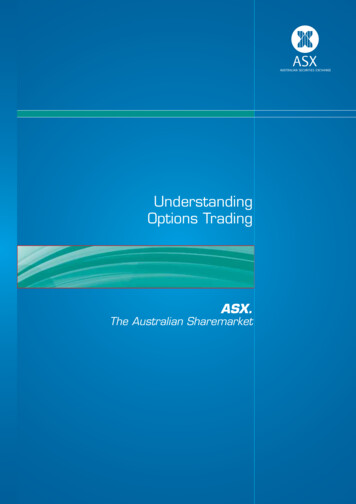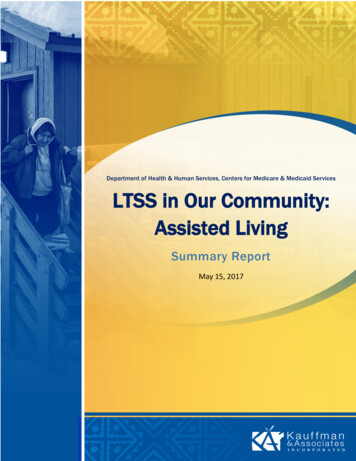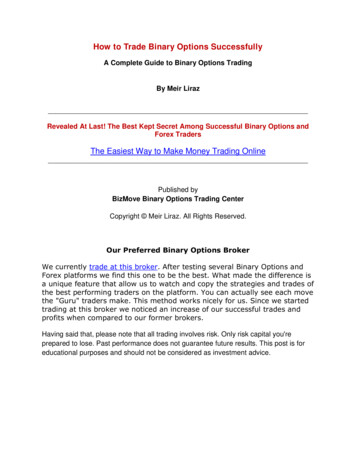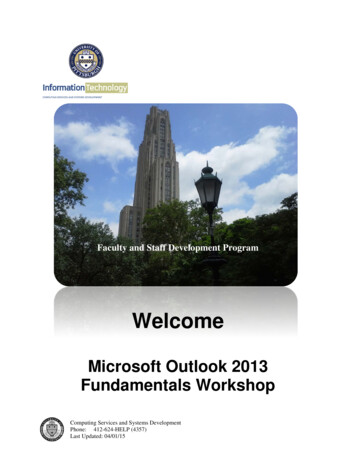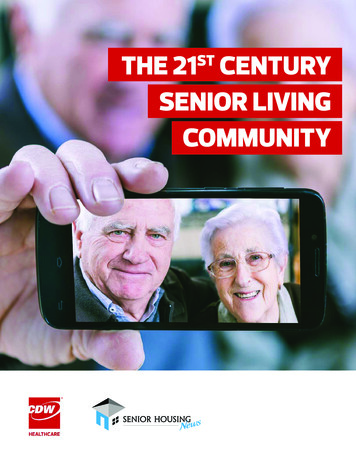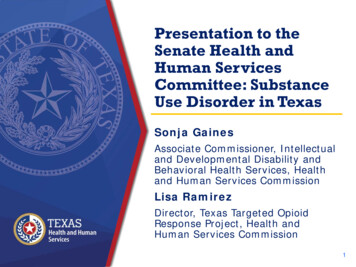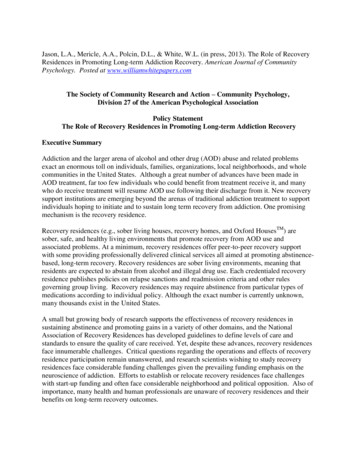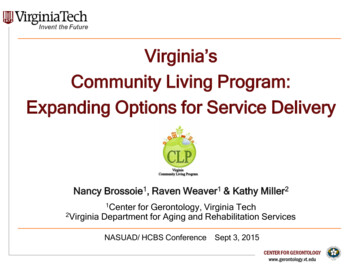
Transcription
Virginia’sCommunity Living Program:Expanding Options for Service DeliveryNancy Brossoie1, Raven Weaver1 & Kathy Miller22Virginia1Centerfor Gerontology, Virginia TechDepartment for Aging and Rehabilitation ServicesNASUAD/ HCBS ConferenceSept 3, 2015CENTER FOR GERONTOLOGYwww.gerontology.vt.edu
Part I: CLP ProgramCOMMUNITY LIVING PROGRAM(NURSING HOME DIVERSION)MODERNIZATION GRANTSCENTER FOR GERONTOLOGYwww.gerontology.vt.edu
AoA NHD GrantsAoA launched the NHD initiative in the fallof 2007. In its initial year, AoA issuedawards to 12 states for a combinedfederal and non-federal funded grantprogram of 8.8 million. In 2008, AoAissued awards to 14 states reaching acombined federal and non-federal amountof approximately 16.2 million. In 2009,AoA issued awards to 16 states.CENTER FOR GERONTOLOGYwww.gerontology.vt.edu
Purpose of AoA NHD Grants Encourage the Aging Services Network tomodernize and transform the funding theyreceive under the Older Americans Act, or othernon-Medicaid sources, into flexible, consumerdirected service dollars Complement the CMS Money Follows thePerson Initiative by strengthening the capacity ofstates to reach older adults before they enter anursing home and spend down to Medicaid Support states’ long-term care rebalancingeffortsCENTER FOR GERONTOLOGYwww.gerontology.vt.edu
Need to Rebalance/TransformCENTER FOR GERONTOLOGYwww.gerontology.vt.edu
Goal of the CLP - 1 Divert 55 individuals who are at imminent riskfrom nursing home placement and Medicaidspend-down through consumer direction ofservices provided within a designated monthlyallotment of up to 1200CENTER FOR GERONTOLOGYwww.gerontology.vt.edu
Consumer-Direction“A philosophy and orientation to the delivery ofhome and community based services wherebyinformed individuals assess their service needs,determine how and by whom these needsshould be met, and monitor the quality ofservices received”National Institute on Consumer Directed Long Term ServicesCENTER FOR GERONTOLOGYwww.gerontology.vt.edu
Options CounselingLong-Term Support Options Counseling is aninteractive decision-support process wherebyconsumers, family members and/or significantothers are supported in their deliberations todetermine appropriate long-term support choicesin the context of the consumer’s needs,preferences, values and individualcircumstances.CENTER FOR GERONTOLOGYwww.gerontology.vt.edu
Goal of CLP - 2 Divert 95 individuals who are at imminent riskfrom nursing home placement and Medicaidspend-down through consumer direction ofservices provided within a designated monthlyallotment of up to 1200CENTER FOR GERONTOLOGYwww.gerontology.vt.edu
Expected Enrollment by AAAAAAAASC# ParticipantsParticipant 083.6541.8Senior Connections1083.6Senior Services14117Shenandoah1083.6Totals95794.2Bay AgingCraterDistrict 3Prince WilliamCENTER FOR GERONTOLOGYwww.gerontology.vt.edu
Expansion Projects in CLP - 2 Bay Aging will evaluate the use of a mobileintake center for enrolling participants in its ruralPlanning and Service AreaCENTER FOR GERONTOLOGYwww.gerontology.vt.edu
Criteria Age: 65 and olderAND Informal Support System Status: Acaregiver demonstrating difficulty meetingthe needs of their family memberANDCENTER FOR GERONTOLOGYwww.gerontology.vt.edu
Criteria continued Functional: Dependent in 2 ADLsOR Cognitive/Emotional Status: Cognitive impairmentsincluding Need for prompting or supervision Impairments in decision-making ability Inability to avoid injury in emergency situationsNote: May have a health condition that requires at least monthly monitoring (e.g.diabetes, heart disease), medical/nursing (skilled care) needs and can be evidencedby a hospitalization or prior nursing facility stay and use of medicationsCENTER FOR GERONTOLOGYwww.gerontology.vt.edu
Targeting Financial Criteria INCOME at or below 300% of SSI (2,022 a month) for theparticipant and likely to be denied Medicaid eligibility due toexcess resources. RESOURCE LEVEL should be no less than and no more thanthese ranges: Single individual: 21,912 - 43,824 Individual with spouse: 43,824- 219,120 The project only considers liquid resources. This would be cashor in any other form which can be converted to cash within 20work days (such as checking, savings, bonds and certificates ofdeposits) If a person is eligible for Medicaid or Medicaid Wavier programs,they are not eligible for this project. A couple can each individually qualify for the programCENTER FOR GERONTOLOGYwww.gerontology.vt.edu
Budget for Participant Monthly budget of 1200 maximum no participant co-pay or partial pay for these services project would pay up to maximum monthly allotment Savings budget A participant could save up to half of the 1,200( 600) a month to purchase a more expensiveservice, such as a ramp Funds authorized for a participant but unspent couldaccumulate in the participants savings budget The maximum allowable savings was 5,000CENTER FOR GERONTOLOGYwww.gerontology.vt.edu
Menu of CLP Service Options Adult Day CareAssisted LivingAssistive DevicesChoreCompanion/HomemakerDental Care (Optional by AAA)Disposable Medical SuppliesGroceriesHome Delivered MealsHome Modification/HousingRehabilitation Nutritional Supplements Personal Care Personal EmergencyResponse System Prescription Medications Recreational Devices Respite Senior Apartments Service Coordination TransportationCENTER FOR GERONTOLOGYwww.gerontology.vt.edu
Provider of Services Participant (consumer)-directed program:the participant was able to choose whoprovided their service Providers could be: A person hired directly by the participant An agency The AAASome services had provider qualifications.There was no limit on personal attendant hours within the 1,200 monthly budget.CENTER FOR GERONTOLOGYwww.gerontology.vt.edu
Payment for Services Payments were being handled through afiscal intermediary, Public Partnerships,LLC (PPL) Tracked the participants monthly and savings budgets Processed all participant paymentsFor personal attendants hired directly by the participant,timesheets were submitted to PPL and payments weremade to the personal attendant. For all other services,AAA paid for the service and then processed invoicesthrough PPL.CENTER FOR GERONTOLOGYwww.gerontology.vt.edu
Expected Outcomes of the CLP A minimum of 95 individuals would be served 80% would be diverted from nursing home placementand Medicaid spend-down 85% of participants and/or their caregivers would reportan improvement in their QOL 85% of participants and/or their caregivers would reportan excellent or good experience with CLPCENTER FOR GERONTOLOGYwww.gerontology.vt.edu
Evaluation by Virginia Tech The Center for Gerontology served as the externalevaluator. The outcome evaluation tracked and reported on clientlevel data and documented the effectiveness of theproject. Evaluators conducted participant/caregiver interviews.CENTER FOR GERONTOLOGYwww.gerontology.vt.edu
Part II: CLP Program ParticipantsCENTER FOR GERONTOLOGYwww.gerontology.vt.edu
Participants153 participants (purchased at least 1 service) Female - 110 (72%)Male - 43 (28%) White – 126 (82%)Black – 26 (17%)Asian – 1 (1%) Hispanic/ Latino – 16 (11%)CENTER FOR GERONTOLOGYwww.gerontology.vt.edu
Relationship StatusLiving Arrangement[CATEGNeverORYNAME] Married1%Spouse& R FOR GERONTOLOGYwww.gerontology.vt.edu
Relationship to Primary[CATEGOCaregiverLiving ArrangementRYNAME]FriendsOtherrelative 4%Spouse& TAGE]CENTER FOR GERONTOLOGYwww.gerontology.vt.edu
Ages of CLP Participants65-69 370-7925.580-8955.690-961501530Percent4560CENTER FOR GERONTOLOGYwww.gerontology.vt.edu
Annual Household Income 7,000 - 9,4998.5 9,500 - 10,9993.3 11,000 - 14,99913.7 15,000 - 19,99913.7 20,000 54.2Unknown1.3015Percent304560CENTER FOR GERONTOLOGYwww.gerontology.vt.edu
Primary ysicalTraumatic UnspecifiedBrain Injury4.6UnknownCENTER FOR GERONTOLOGYwww.gerontology.vt.edu
ADL TER FOR GERONTOLOGYwww.gerontology.vt.edu
Unenrolled40 (26%) unenrolled 19 died 8 needed more intensive home services 5 transitioned to nursing home or hospital 3 no longer met financial eligibility criteria 1 dissatisfied with program 4 unknownCENTER FOR GERONTOLOGYwww.gerontology.vt.edu
Services Purchased: RoutinePersonal Care60.1Companion/ Homemaker40.5PERS13.7Adult Day Care11.1Transportation11.1Meals7.8Assisted Living7.8Senior Housing4.301530Percent4560CENTER FOR GERONTOLOGYwww.gerontology.vt.edu
Participantsn (%)AverageMonthsPurchasedRange SpentAverageMonthly SpentPersonal Care92 (60%)5.2 83 - 11,360 779Companion/Homemaker62 (41%)4.9 98 - 11,900 541PERS21 (18%)4.8 22 - 450 39Adult Day Care17 (11%)4.0 50 - 10,513 564Transportation17 (11%)3.5 18 - 6,017 194Meals12 (8%)4.0 50 - 870 98Assisted Living12 (8%)4.8 403 - 9,600 1,032ServiceCENTER FOR GERONTOLOGYwww.gerontology.vt.edu
Personal Hire vs Agency Hire AidesRangeHourly PayRange SpentAverage Monthly SpentHired Own 7.25 - 16 552 - 11,261 1,011Agency Staff 14.50 - 37 83 - 11,360 667ServicePersonal CareCompanion/HomemakerHired Own 7.25 - 16 168 - 10,176 769Agency Staff 11.75 - 22 98- 11,900 482CENTER FOR GERONTOLOGYwww.gerontology.vt.edu
Services Purchased:One-Time / IntermittentDisposible Medical SuppliesHome ModificationsMedicationsAssistive DevicesChoreNutritional 83.92.620510Percent1520CENTER FOR GERONTOLOGYwww.gerontology.vt.edu
Participants n(%)Range SpentAverage SpentMed Supplies25 (16%) 20 - 1,932 409Home Mods25 (16%) 115 - 4,200 1,117Medications23 (15%) 14 - 1,492 567Assistive Devices23 (15%) 21 - 3,321 454Chore15 (10%) 66 - 2,210 734Nutritional Sup12 (8%) 14 - 604 146Respite6 (4%) 38 - 2,204 899Groceries4 (3%) 82 - 1,967 734Dental3 (2%) 228 - 2,255 1,087ServiceCENTER FOR GERONTOLOGYwww.gerontology.vt.edu
Types of Home Modifications Building wheelchair ramps Installing a stair lift Repairing a driveway Upgrading a home heating system Upgrading plumbing Purchasing laundry appliancesCENTER FOR GERONTOLOGYwww.gerontology.vt.edu
Remaining Unmet Needs41% lacked needed transportation26% did not make it to the bathroom in time21% missed doses of medication15% needed help bathing9% skipped meals for lack of food8% did not feel safe in their homeCENTER FOR GERONTOLOGYwww.gerontology.vt.edu
Minor Differences Among AAA SitesRecruitment Current Clients Selected Current Clients & Community Outreach Community OutreachServices Service Coordination Availability and Selection Promotion of Personal Hire Aides/ Agency AidesCENTER FOR GERONTOLOGYwww.gerontology.vt.edu
Success!NH Diversion Outcomes Participants engaged in the care process 95% participants diverted from NH care &Medicaid enrollment Participants spent less than monthly allotment Average expenditures 26.33/day ( 800/mo) Medicaid NH costs in region 136 - 169/dayCENTER FOR GERONTOLOGYwww.gerontology.vt.edu
Part III: Service Use PatternsCENTER FOR GERONTOLOGYwww.gerontology.vt.edu
Service Use Patterns Groups of service users Groups of services purchasedCENTER FOR GERONTOLOGYwww.gerontology.vt.edu
Groups of Service Users Identify groups of service users (based onpersonal characteristics). How are groups associated with types ofservices purchased? Does perceived health status and programeffectiveness differ by groups of users?CENTER FOR GERONTOLOGYwww.gerontology.vt.edu
Study Sample Inclusion criteria Enrolled in CLP for 31 days Purchased 2 services 76 participants Age range 66-95 (M 83.2)67% women (n 51)83% White non-Hispanic47% married, 40% widowedM 4.51 ADL limitationsM 4.77 chronic health conditionsCENTER FOR GERONTOLOGYwww.gerontology.vt.edu
POPULATIONHEALTH BEHAVIORSOUTCOMESCHARACTERISTICSPredisposing AgeNeed Primary disability type Number of ADLlimitationsEnabling Resources Living situation Household income Caregiver relationshipto participant Length of time (years)caregivingUse ofAvailableServicesProgram Effectiveness Average cost per day Reported number ofexisting unmet needsPerceived Health Status Likelihood of nursinghome entry withoutCLP services Likelihood of nursinghome entry within thenext three monthsFigure 1. Variables used to examine service use among vulnerable olderadults. Adapted from Andersen (1995).CENTER FOR GERONTOLOGYwww.gerontology.vt.edu
Groups of Service Users Four distinct profiles of vulnerable older adults basedon predisposing, enabling*, and need-based factors Conventional Older Adults (n 19) Living arrangement variability, more years with caregivers providing care, householdincome variability Primarily physical disability Living with Adult Child (n 16) Living with adult child, more years with caregivers providing care, less householdincome Physical or cognitive disability Greater Resources (n 24) Living with spouse only, fewer years with caregivers providing care, greater householdincome Primarily cognitive disability Extended Kin and Friend Support (n 7) Living alone, fewer years with caregivers providing care, household income variability Only physical disabilityCENTER FOR GERONTOLOGYwww.gerontology.vt.edu
Service Use Implications 16 of the 18 available services were used M 3.08 servicesAlmost all participants selected PCSNearly half selected homemaker/companion servicesHighlights the need to provide various service options to reduce the risk of needsgoing unmetOther service use findings Conventional HCBS users: suggests awareness of current needs (assistivedevices, chore services) AND consideration of future needs (home modification)Living with Adult Child: importance of respite services when providing care for alonger period of timeGreater resources: suggests the importance of routine services (ADC,transportation)Extended kin and friend support: purchased the fewest type of services, reflectsphysical limitationsCENTER FOR GERONTOLOGYwww.gerontology.vt.edu
Outcome Measures Existing Unmet Need Number of remaining unmet needs Program Effectiveness Cost per day Existing unmet need Perceived Health Status Likelihood of nursing home entry in the next 3 months Likelihood of nursing home entry without CLPservicesCENTER FOR GERONTOLOGYwww.gerontology.vt.edu
Program EffectivenessUnmet Needs by Cluster1.81.61.41.210.80.60.40.20M 1.391234ClusterNo significant difference between clustersCENTER FOR GERONTOLOGYwww.gerontology.vt.edu
Program EffectivenessCost Per Day by Cluster3530M 28.0725201510501234ClusterSignificant difference between Cluster 1 and 2 & Cluster 1 and 3CENTER FOR GERONTOLOGYwww.gerontology.vt.edu
Perceived Health StatusLikelihood of Nursing Home EntryWithout CLP Services by Cluster3.532.521.510.50M 2.281234ClusterSignificant difference between Cluster 3 and Cluster 4 ( p .101)CENTER FOR GERONTOLOGYwww.gerontology.vt.edu
Perceived Health StatusLikelihood of Nursing Home Entryin the Next 3 Months by Cluster1.451.41.35M 1.341.31.251.21.151.11234ClusterNo significant difference between clustersCENTER FOR GERONTOLOGYwww.gerontology.vt.edu
What does this tell us? 16 of the 18 available services were purchased PCS and Homemaker/Companion services a rangeof services Highlights the need to provide various service optionsto reduce the risk of needs going unmet Importance of Enabling Resources Length of time caregiving: Respite service associatedwith living with adult child (had been providing care fora longer time period)—caregiver strain Living situation: Association between family supportand likelihood of nursing home entryCENTER FOR GERONTOLOGYwww.gerontology.vt.edu
Groups of Services Purchased 7 distinct clusters Identified by analyzing purchasingpatterns of participantsCENTER FOR GERONTOLOGYwww.gerontology.vt.edu
Menu of ServicesAdult Day CareAssisted LivingAssistive DevicesChoreCompanion/HomemakerDental Care (Optional byAAA) Disposable MedicalSupplies Groceries Home Delivered Meals Home Modification/HousingRehabilitation Nutritional Supplements Personal Care Personal EmergencyResponse System Prescription Medications Recreational Devices Respite Senior Apartments Service Coordination TransportationCENTER FOR GERONTOLOGYwww.gerontology.vt.edu
Model #1PersonalCareAL CostsPrescriptionMedicationHome ModsDisposableMed alsTransportationCENTER FOR GERONTOLOGYwww.gerontology.vt.edu
Model #2PersonalCareAL CostsPrescriptionMedicationsDisposableMed SuppliesAssistiveDevicesGroceriesHome entalADCRespitePERSMealsCENTER FOR GERONTOLOGYTransportationwww.gerontology.vt.edu
Model #2 ationsAssistedLiving lt R FOR GERONTOLOGYwww.gerontology.vt.edu
Using Service ClustersService clusters do not predict needUseful in developing HCBS programs identifying short-term and long-term serviceneeds.Services linking clusters serve as markers or potential transition points toconsider when planning current and future needsCENTER FOR GERONTOLOGYwww.gerontology.vt.edu
Discussion The CLP intervened before clients’ needs were too dire. capitalized on the strengths of informalcaregiving. allowed older adults to identify the services theyneed.CENTER FOR GERONTOLOGYwww.gerontology.vt.edu
Discussion cont.Organizing services and service delivery withgreater potential to meet older adults’ careneeds Targeting enabling resources of clients Providing preventive service options Supplementing informal caregiving effortswith services and supports Prioritizing widespread availability of PCSand Homemaker/Companion servicesCENTER FOR GERONTOLOGYwww.gerontology.vt.edu
CLP Sustainability Letters of commitment Lack of continued funding No new grant opportunitiesState budget reductionsOAA not reauthorizedOnly Title IIIB funding availableCENTER FOR GERONTOLOGYwww.gerontology.vt.edu
ImplicationsA primary concern for practitioners and policymakers: how toprovide HCBS that address comprehensive care needs of thegrowing population of older adults in the United States? National care policies assumption that familial support is available and reliable perceived likelihood of nursing home entryCENTER FOR GERONTOLOGYwww.gerontology.vt.edu
Implications cont. Program planning Findings suggest necessity of formal services tosupplement informal care outside the realm oftraditional family structures For preventive care to be effective, serviceagencies must identify and addresscomprehensive needs of clients before needs aretoo dire Policy initiatives Economic incentive for federal and stategovernments to support HCBS programs such asCLPCENTER FOR GERONTOLOGYwww.gerontology.vt.edu
Future Research a crossroad to determine how to efficientlyand effectively advance and incorporate asystem of preventive health care forvulnerable older adults Dynamic interplay among individuals’ needs anddisabilities Frequency of service use Alternative informal care options Long-term outcomes for both individual users andtheir caregiversCENTER FOR GERONTOLOGYwww.gerontology.vt.edu
Questions&CommentsContact InformationRaven WeaverRaven89@vt.eduCENTER FOR GERONTOLOGYwww.gerontology.vt.edu
LLC (PPL) Tracked the participants monthly and savings budgets Processed all participant payments For personal attendants hired directly by the participant, timesheets were submitted to PPL and payments were made to the personal attendant. For all other services, AAA paid for the service
